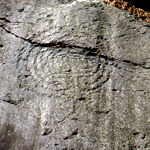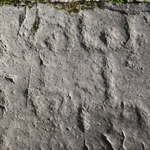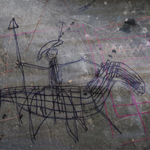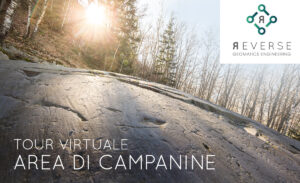Difficulty: Medium
Duration: 2 hours
The rock art known up to now in the area of Cimbergo concentrates in Campanine, a very large area west to the village, at a height between 400 and 800 metres above sea level and on a mountainside here and there interrupted by small plateaus and marked by steep rock walls. The recent complete analysis of the area stresses the presence of 102 carved rocks and a millenia-old frequentation, just in this case covering also historic times (14th–16th centuries). The prehistoric rock art in Campanine shows an undisputable local identity, thanks to a peculiar range of styles and subjects that clearly distinguishes this area from the other sites of the Middle Valley, though also the common figurative code appears to be engraved here as well. For example, among its figures it is important to point out the unusually large number of water birds, the peculiar typologies of depicted buildings, the several square-bladed axes, and the many footprints (marked by unique varieties even when compared to sites similarly rich of the same subject, such as Foppe di Nadro and Naquane).
The visiting routes that are open to the public only cover the area of Campanine Alta, where the most representative presence of Middle Ages engravings can be found; some contiguous sub-areas are kept closed because of preservation and safety reasons. For a basic view of the site, we recommend to visit Rocks 1, 5-6-7, 8, 20, 21, 23-26, 25.
The site can be reached after getting the entrance ticket at Nadro Museum and driving on the road linking Ceto to Cimbergo. As soon as you reach the plain area at the foot of the rock hill where the village of Cimbergo is set, with its ruined fortress clearly visible on the Northern side of the village, there is a parking place near the starting point of the main route, which goes down along the deep gorge of the Rè stream. After an about 15-minute walk, the path reaches a little chapel and the first rocks supplied with touristic panels.
Trail details

LENGTH: 2 Km (roundtrip)
ALTITUDE: Max 790 – Min 720
DIFFERENCE IN ALTITUDE: 70 m
KIND OF PATH: Unpaved hiking trail
DIFFICULTY: Easy
For the link to the trail, click here
Virtual Tour
Campanine R1
 A large rock surface, comprising two engraved sections. The lower panel is distinguished by a rare figure of a labyrinth, of the so-called “Cretan” type, with one whole course going from the outside towards the centre, developing in seven spires. The labyrinth, a fairly unusual symbol in Camunian rock art (other instances occur at Naquane, Zurla, Luine, Dos del Mirichì, Piancogno), may evoke a complex journey that transforms the ones who take it; so, it is probably linked to rites of passage (birth, puberty, wedding, death). In this case, the labyrinth is associated with square-bladed axes and a monstrous figure of a horned and ithyphallic bird, likely from the mythological sphere. This central scene is surrounded by more images: huts, other warriors, and footprints.
A large rock surface, comprising two engraved sections. The lower panel is distinguished by a rare figure of a labyrinth, of the so-called “Cretan” type, with one whole course going from the outside towards the centre, developing in seven spires. The labyrinth, a fairly unusual symbol in Camunian rock art (other instances occur at Naquane, Zurla, Luine, Dos del Mirichì, Piancogno), may evoke a complex journey that transforms the ones who take it; so, it is probably linked to rites of passage (birth, puberty, wedding, death). In this case, the labyrinth is associated with square-bladed axes and a monstrous figure of a horned and ithyphallic bird, likely from the mythological sphere. This central scene is surrounded by more images: huts, other warriors, and footprints.
The second panel also shows the hut motif and footprints.
Campanine R5
 This remarkable engraved section, just above a small farmhouse, was covered by soil and vegetation. Today, it appears like an outcrop in itself, which continues to develop the imagery of Rocks 6 and 7.
This remarkable engraved section, just above a small farmhouse, was covered by soil and vegetation. Today, it appears like an outcrop in itself, which continues to develop the imagery of Rocks 6 and 7.
Rock 5 is characterized by the co-presence of historic and prehistoric figures, in superimposition: in the upper part you can fairly clearly see figures of huts, a scene of deer hunt (very rare in this area), a scratched labyrinth and several warriors, attributable to the Iron Age; the central and lower sections are hard to decipher because of sundry superimpositions, however, it is possible to distinguish writings in North-Etruscan characters and in Latin (“IOVIS”), and more recent Christian crosses. Particularly important, on the right-hand side, is an anthropomorphic figure holding three keys, that can be compared to the Christian iconography of Saint Peter.
Campanine R6
 On the contiguous R6, the first engravings to be noted are several crosses and two extraordinary dates written in Latin numberals – “?CCCIX” and “?CCCXXX” (1319 and 1330, respectively). The “?” sign indicates a late evolution of the classical “M”, and follows a palaeographic rule that does not appear after the 15th century. However, the most striking examples of rock art here are represented by the great number of scratched images, among which there are several gallows (in one case, with the depiction of the condemned person hanging by one foot), Solomon knots, inscriptions, stairs-shaped figures, five-pointed stars, crossbows, some large heraldic symbols (such as the crowned eagle, symbol of the powerful local noble family Federici), couples of dices (perhaps a reference to the Passion of Jesus), a priest on his knees with a mitre on his head, a human figure holding a sickle (maybe Death?), the depiction of a tuber (recently interpreted as a possible representation of the magical mandrake root), and other schematic signs of difficult identification.
On the contiguous R6, the first engravings to be noted are several crosses and two extraordinary dates written in Latin numberals – “?CCCIX” and “?CCCXXX” (1319 and 1330, respectively). The “?” sign indicates a late evolution of the classical “M”, and follows a palaeographic rule that does not appear after the 15th century. However, the most striking examples of rock art here are represented by the great number of scratched images, among which there are several gallows (in one case, with the depiction of the condemned person hanging by one foot), Solomon knots, inscriptions, stairs-shaped figures, five-pointed stars, crossbows, some large heraldic symbols (such as the crowned eagle, symbol of the powerful local noble family Federici), couples of dices (perhaps a reference to the Passion of Jesus), a priest on his knees with a mitre on his head, a human figure holding a sickle (maybe Death?), the depiction of a tuber (recently interpreted as a possible representation of the magical mandrake root), and other schematic signs of difficult identification.
This rich and complex panel is testimony to the intense frequentation of this area between the end of the Middle Ages and the beginning of Modern Age, thus putting the historic engraving activity (at least in this site) under a completely new light. The act of carving signs on the rock in historic times, in fact, should not be simply read as a Christian way to consecrate or “exorcise” previously pagan sites (a widespread opinion until recently), but as an actual parallel engraving activity that was probably led by educated people (due to the erudite origin of most of the subjects), perhaps members of the clergy or even of the middle class, that new social class that right in those years was strengthening its power not only in Valcamonica, but also throughout the entire Italian peninsula.
Campanine R7
 R7 is part of the large outcrop that, once partially covered with soil and vegetation, currently includes with no interruption also R5 and R6. R7 is the large top surface and shows praying figures (sometimes in vertical or horizontal combination), some building figures, warriors, and square-bladed axes, dating back to the Middle Iron Age. On an isolated part of the rock, some metres to the North, there is one of the largest building representations (over 1 m high) in the entire rock art examples from Valcamonica; on the upper part, it is possible to observe a very rich panel engraved in historic times (13th-14th centuries), with over forty images of keys, crosses, and other Christian symbols. The key sign has been recently interpreted as a statement, especially from a symbolic point of view, of civil power and may be linked to the several representations of buildings (castles, towers, and fortifications) that can be found immediately below.
R7 is part of the large outcrop that, once partially covered with soil and vegetation, currently includes with no interruption also R5 and R6. R7 is the large top surface and shows praying figures (sometimes in vertical or horizontal combination), some building figures, warriors, and square-bladed axes, dating back to the Middle Iron Age. On an isolated part of the rock, some metres to the North, there is one of the largest building representations (over 1 m high) in the entire rock art examples from Valcamonica; on the upper part, it is possible to observe a very rich panel engraved in historic times (13th-14th centuries), with over forty images of keys, crosses, and other Christian symbols. The key sign has been recently interpreted as a statement, especially from a symbolic point of view, of civil power and may be linked to the several representations of buildings (castles, towers, and fortifications) that can be found immediately below.
Campanine R8
 This small but significant panel represents what probably are the oldest ploughing scenes in Europe: two couples of yoked “bucrania” (lit., “bull skulls”), with a coeval set of figures. The chronology of this composition is still uncertain: scholars suggest a time range that goes from Late Neolithic (mid IV millennium BCE) to the Copper Age (2,900 – 2,200 BCE) and the Early Bronze Age (2,200 – 1,600 BC). In Late Neolithic/Early Copper Age, stylized patterns were quite common and the (rare) oxen are represented as stylized “bucrania”; furthermore, the bucrania on this panel are in close connection with a set of “maculae”, the first topographic representations. On the other side, the complex structure of the plough seems to suggest an early Bronze Age typology.
This small but significant panel represents what probably are the oldest ploughing scenes in Europe: two couples of yoked “bucrania” (lit., “bull skulls”), with a coeval set of figures. The chronology of this composition is still uncertain: scholars suggest a time range that goes from Late Neolithic (mid IV millennium BCE) to the Copper Age (2,900 – 2,200 BCE) and the Early Bronze Age (2,200 – 1,600 BC). In Late Neolithic/Early Copper Age, stylized patterns were quite common and the (rare) oxen are represented as stylized “bucrania”; furthermore, the bucrania on this panel are in close connection with a set of “maculae”, the first topographic representations. On the other side, the complex structure of the plough seems to suggest an early Bronze Age typology.
Campanine R20
 A large surface, beautifully shaped by glacier action. The engravings, which are difficult to read, refer to the Iron Age and are rather repetitive: the only themes expressed are huts and armed men, plus just a few other subjects. Of a later phase, in the middle of the historical period, are the depictions of two keys and an anthropomorph (probably wearing a sort of cloak), plus a cross and some short inscriptions (the latter made using the filiform technique).
A large surface, beautifully shaped by glacier action. The engravings, which are difficult to read, refer to the Iron Age and are rather repetitive: the only themes expressed are huts and armed men, plus just a few other subjects. Of a later phase, in the middle of the historical period, are the depictions of two keys and an anthropomorph (probably wearing a sort of cloak), plus a cross and some short inscriptions (the latter made using the filiform technique).
Campanine R21

The main panel shows a complex scene with prayers (male and female, as well as asexual ones) associated with cup-marks, both single or grouped in modules. It seems to read as a choral scene, in which the female orants are assisted by a “swaddled” orant, with a sort of cloak rendered by means of two vertical lines joining elbows and knees (like the one on R20). This figure is placed slightly more aloof, perhaps to highlight his role as guide/officiant of some particular rite, or as a priest. Arranged around are other praying figures (also very worn), a reticulum, and a disk. Of later date are two pairs of duelists, of two different styles (one datable to the Late Bronze Age/Early Iron Age, the other to the Ancient Iron Age) and a square-bladed axe (Early/Middle Iron Age).
In the other sectors, in addition to other orants (of which one among others is still paludate, though incomplete), again associated with cupmarks, both single and in module, there are also some footprints – both simple or internally decorated, with horizontal and parallel lines and one with zigzag lines.
Campanine R23-26
 Rocks 23 and 26 make a unite group scene of historic time, dateable from the 14th to the 15th century CE. On Rock 23 there are only three thin lines, running lengthways on the whole surface, with quadrangular arches at the bottom and a small cross at the top. Rock 26 is incredibly rich of scenes made with the “filiform” (scratching) technique, including some reticula that could represent towers; a possible parade through crested tents, a dressed knight wearing a crest, an armed horn player, standards and standard bearers; a completely armed figure wearing a helmet, an armour, a big sword supported by chains and a small triangular shield; two drafted knights, one of which has a big spear; finally, other less easily recognizable figures, among which are some horses. Another extremely interesting figure is the great tower that was made in a later phase (15th century), using the pecking technique: it has a portal and Ghibelline battlements, hosting the small figure of a standard bearer, who is holding a large flag with a key on it.
Rocks 23 and 26 make a unite group scene of historic time, dateable from the 14th to the 15th century CE. On Rock 23 there are only three thin lines, running lengthways on the whole surface, with quadrangular arches at the bottom and a small cross at the top. Rock 26 is incredibly rich of scenes made with the “filiform” (scratching) technique, including some reticula that could represent towers; a possible parade through crested tents, a dressed knight wearing a crest, an armed horn player, standards and standard bearers; a completely armed figure wearing a helmet, an armour, a big sword supported by chains and a small triangular shield; two drafted knights, one of which has a big spear; finally, other less easily recognizable figures, among which are some horses. Another extremely interesting figure is the great tower that was made in a later phase (15th century), using the pecking technique: it has a portal and Ghibelline battlements, hosting the small figure of a standard bearer, who is holding a large flag with a key on it.
Campanine R25
 A large surface carved with plenty of images, in some cases almost completely erased by the wearing caused by passing people. The most noteworthy petroglyphs are the groups of praying figures, some Iron Age warriors, and a couple of tiny footprints turned downhill.
A large surface carved with plenty of images, in some cases almost completely erased by the wearing caused by passing people. The most noteworthy petroglyphs are the groups of praying figures, some Iron Age warriors, and a couple of tiny footprints turned downhill.
